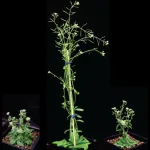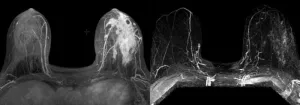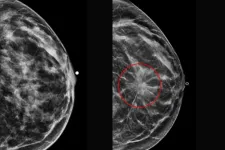(Press-News.org) Within all complex, multicellular living systems such as plants and humans, there exists a set of genetic elements that can be likened to the blueprints, tools, and specialized personnel at a construction site for an expanding development. Plant biologists like Aman Husbands at the University of Pennsylvania study a family of skilled subcontractors, known as the HD-ZIPIII transcription factors (TFs). These subcontractors are tasked with deciding which blueprints, or genes, to follow as they guide the development of a plant’s form and features, such as its plumbing—analogous to the vasculature—and structural components like roots and leaf shapes.
However, despite sharing overlapping blueprints and access to the same tools, each HD-ZIPIII family member, like CORONA (CNA) and PHABULOSA (PHB), has a unique way of interpreting these blueprints and using their tools. These differences lead to distinct and measurable outcomes in the structures they help create.
“Now, the million-dollar question,” Husbands says, “is, ‘How do you get these functionally divergent outcomes?’”
In a paper published in Nature Communications, Husbands and the team focused on two near-identical paralogs, PHB and CNA, to uncover the mechanism behind this divergence.
“We found that while these two transcription factors bind to the same regions of DNA, they regulate different genes, resulting in unique developmental outcomes,” Husbands says. “This surprising discovery points to a small but crucial feature of the transcription factors: their START domain,” a lipid-binding region within the TFs, which the researchers liken to a foreman’s decision-making tool, dictating how the blueprints are executed at each site.
By swapping the START domains of PHB and CNA, the researchers demonstrated that this single change could alter their function, effectively rewriting the developmental instructions.
“The implications are pretty significant, not just for other plant biologists and researchers in this space,” says first author Ashton Holub, a former postdoctoral researcher in the Husbands Lab. “In synthetic biology or gene therapy, transcription factors with off-target effects can cause some concerning unintended consequences, so, by understanding and being able to manipulate mechanisms like the START domain, we can someday fine-tune genetic tools to minimize risks and achieve precise outcomes.”
Where CNA and PHB work and what they do
The researchers initially explored the functional divergence between the CNA and PHB by performing qPCR, a quantitative technique used to measure the abundance of RNA molecules and, by extension, gene-expression levels. Initially, they focused on examining two genomic targets they expected CNA and PHB to regulate based on the team’s previous research and assumptions about TFs based on other literature.
However, Holub says, the qPCR results revealed an unexpected finding. Although one type of location-based test (ChIP-qPCR) found that CNA and PHB were binding to the same target sites, another that examines the effects of the binding activity (RT-qPCR) showed they didn’t always produce a regulatory effect. “We saw binding at these spots but no changes in gene expression,” he says, “which really forced us to think more broadly and explore the full genome rather than just a couple of sites.”
To address this paradox, they turned to ChIP-seq to systematically map all the binding sites of CNA and PHB across the genome, thus allowing the researchers to see the broader landscape of where TFs were binding. To complement this, they used RNA-seq (transcriptome profiling) to measure changes in gene expression at a genome-wide scale. This combination of techniques enabled the team to determine not just where CNA and PHB were binding but also which genes were being activated or repressed as a result.
Holub says, “qPCR showed us the anomaly, and ChIP-seq and RNA-seq gave us the complete story.”
The START Domain: A critical decision-maker
The results pointed the researchers toward a key feature of CNA and PHB: their START domain, a lipid-binding part of the proteins that imbues them with certain transcriptional abilities.
“One of the interesting things about these TFs is that they have this START domain, which you also see in other proteins across the tree of life,” Husbands says. “These domains are important for development, stress responses, and even disease. When we saw them in these TFs, we hypothesized that they were the reason CORONA and PHB might function differently.”
To test this hypothesis, the researchers generated chimeric CNA proteins by swapping its START domain with those from PHB, or even from species separated by hundreds of millions of years of evolution. “Our experiments confirmed that the START domain was the critical determinant,” says Sarah Choudury, a postdoctoral researcher in the Husbands Lab. “It wasn’t where these TFs bound that changed; it was how they regulated the genes they bound to.”
By deleting, mutating, and swapping START domains, the researchers demonstrated that this small region acted as a decision-making tool, dictating whether a gene was activated or suppressed. Even small changes in the START domain had significant impacts, illustrating how this mechanism contributes to the diversity of gene regulation.
In noting how the START domain enables a single set of binding sites to generate a wide range of developmental instructions, Husbands flipped the familiar Latin phrase “e pluribus unum” (out of many, one) on its head, remarking, “Out of one, many. Out of one bound network, you can get a diversity of regulatory programs.”
Husbands and the team are now exploring how this mechanism operates in other transcription factor families, as well as in species beyond the model used for this research, Arabidopsis thaliana.
“We’re testing whether this kind of differential regulation is a generalizable feature across evolution,” Holub says. “If it’s happening in plants, there’s every reason to believe it could be happening in animals, too.”
The team wants to understand the finer details of how START domains interact with other cellular components to influence gene regulation. “There’s so much we still don’t know,” Choudury says. “What about transcription factors that don’t have START domains? Are there parallel mechanisms at play? And how do these domains sense and respond to the environment?”
Aman Husbands is the Mitchell J. Blutt and Margo Krody Blutt Presidential Assistant Professor of Biology in the Department of Biology in the School of Arts & Sciences.
Ashton Holub is a former postdoctoral researcher in the Husbands Lab at Penn Arts & Sciences and now a fellow at Nationwide Children’s Hospital.
Sarah Choudury is a postdoctoral researcher in the Husbands Lab at Penn Arts & Sciences.
Other authors are Ricardo Urquidi Camacho and Courtney E. Dresden of Penn Arts & Sciences and Ekaterina P. Andrianova and Igor B. Zhulin of Ohio State University.
This work was supported by the National Science Foundation (grants 2039489 and 2310356).
END
From one gene switch, many possible outcomes
A team of researchers led by Aman Husbands of the School of Arts & Sciences has uncovered surprising ways transcription factors—the genetic switches for genes—regulate plant development, revealing how subtle changes in a lipid-binding region can drama
2024-12-05
ELSE PRESS RELEASES FROM THIS DATE:
Visiting Fellows selected for inaugural cohort of the Africa-UBC Oceans and Fisheries Visiting Fellows Program
2024-12-05
The Africa-UBC Oceans and Fisheries Visiting Fellows Program is extremely pleased to announce the selection of its inaugural laureates: Dr. Cynthia A. Adinortey (Ghana) and Dr. Antony Otinga Oteng’o (Kenya).
“We had many excellent applicants from across Sub-Saharan Africa. Ultimately, our Selection Committee selected these two exemplary scholars, and we are most happy with the result,” said Dr. William Cheung, professor and Director of UBC’s Institute for the Oceans and Fisheries (IOF), which administers the Program. “These two exemplary scholars will now have the opportunity to collaborate ...
Innovative immunotherapy shows promise in early clinical trial for breast cancer
2024-12-05
A groundbreaking phase one clinical trial exploring a novel cell-based immunotherapy for breast cancer has been accepted for publication in JAMA Oncology. The technology tested in the trial was co-developed by Gary Koski, Ph.D., professor in Kent State University’s Department of Biological Sciences, and Brian J. Czerniecki, M.D., Ph.D., chair and senior member in the Moffitt Cancer Center’s Department of Breast Oncology. The study focuses on a new treatment approach that aims to harness the body’s immune system to enhance patient responses ...
Whiteness as a fundamental determinant of health in rural America
2024-12-05
WASHINGTON -- White people in rural America have unique factors that drive worse health outcomes than their urban counterparts, prompting a team of public health researchers to label whiteness as a fundamental determinant of health. They say while the health and well-being of racially minoritized populations should continue to be a research priority they urge researchers to consider factors that influence the health of majoritized populations.
In an analytic essay, "Whiteness: A Fundamental Determinant of the Health of Rural White Americans,” published Dec. 5 in the American Journal of Public Health, Caroline Efird, PhD, MPH, ...
Analyzing multiple mammograms improves breast cancer risk prediction
2024-12-05
A new study from Washington University School of Medicine in St. Louis describes an innovative method of analyzing mammograms that significantly improves the accuracy of predicting the risk of breast cancer development over the following five years. Using up to three years of previous mammograms, the new method identified individuals at high risk of developing breast cancer 2.3 times more accurately than the standard method, which is based on questionnaires assessing clinical risk factors alone, such as age, race and family history of breast cancer.
The study is published ...
Molecular zip code draws killer T cells straight to brain tumors
2024-12-05
More information, including a copy of the paper, can be found online at the Science press package at https://www.eurekalert.org/press/scipak.
Molecular Zip Code Draws Killer T Cells Straight to Brain Tumors
Researchers have found a way to program immune cells to attack glioblastoma and treat the inflammation of multiple sclerosis in mice. The technology will soon be tested in a clinical trial for people with glioblastoma.
UCSF scientists have developed a “molecular GPS” to guide immune cells into the brain and kill tumors without harming healthy tissue.
This living cell therapy can navigate through the body to a specific organ, addressing ...
Engineered immune cells may be able to tame inflammation
2024-12-05
More information, including a copy of the paper, can be found online at the Science press package at https://www.eurekalert.org/press/scipak.
Engineered Immune Cells May Be Able to Tame Inflammation
Immune cells that are designed to soothe could improve treatment for organ transplants, type 1 diabetes and other autoimmune conditions.
When the immune system overreacts and starts attacking the body, the only option may be to shut the entire system down and risk developing infections or cancer.
But now, scientists at UC San Francisco may have found a more precise way to dial the immune system down.
The technology ...
Rapid surge in global warming mainly due to reduced planetary albedo
2024-12-05
Rising sea levels, melting glaciers, heatwaves at sea – 2023 set a number of alarming new records. The global mean temperature also rose to nearly 1.5 degrees above the preindustrial level, another record. Seeking to identify the causes of this sudden rise has proven a challenge for researchers. After all, factoring in the effects of anthropogenic influences like the accumulation of greenhouse gases in the atmosphere, of the weather phenomenon El Niño, and of natural events like volcanic eruptions, can account for a major portion of the warming. But doing so still leaves a gap of roughly 0.2 degrees Celsius, which has never been satisfactorily ...
Single mutation in bovine H5N1 switches viral binding specificity to human receptors
2024-12-05
A single mutation in bovine influenza H5N1 – a clade of the highly pathogenic avian influenza virus that has been increasingly detected among North American livestock herds – can cause the virus to switch affinity from animal-type receptors to human-type receptors, according to a new study. The findings highlight the crucial need for continuous surveillance of emerging H5N1 mutations, as even subtle genetic changes could increase the virus's capacity for human adaptation and transmission, potentially triggering a future influenza pandemic. In 2021, the highly pathogenic influenza H5N1 clade ...
Discovered: the neuroendocrine circuit that dictates when fish are ready to hatch
2024-12-05
Researchers have uncovered a previously unknown yet crucial role for thyrotropin-releasing hormone (Trh) in zebrafish hatching and reveal how this hormone activates a transient neuroendocrine circuit that controls when fish larvae are ready to leave the egg and swim free. For egg-born animals, hatching marks a pivotal shift, transitioning from the sheltered environment of an egg capsule to external conditions. This crucial event is not strictly hardwired into the embryo’s developmental program. Rather, hatching is a regulated ...
Climate change threatens global biodiversity, with extinction risks escalating at higher temperatures
2024-12-05
Climate change is driving global extinction risks, with 1.6% of species threatened at 1.3°C of warming and risks escalating to 29.7% at 5.4°C, according to a new meta-analysis encompassing more than 30 years of research. Climate change is reshaping ecosystems and biodiversity globally, altering species distributions, interactions, and population dynamics. While some species adapt or migrate to track shifting climates, others face population declines, shrinking ranges, and potential extinction. ...
LAST 30 PRESS RELEASES:
University of Oklahoma researcher awarded funding to pursue AI-powered material design
Exploring how the visual system recovers following injury
Support for parents with infants at pediatric check-ups leads to better reading and math skills in elementary school
Kids’ behavioral health is a growing share of family health costs
Day & night: Cancer disrupts the brain’s natural rhythm
COVID-19 vaccination significantly reduces risk to pregnant women and baby
The role of vaccination in maternal and perinatal outcomes associated with COVID-19 in pregnancy
Mayo Clinic smartwatch system helps parents shorten and defuse children's severe tantrums early
Behavioral health spending spikes to 40% of all children’s health expenditures, nearly doubling in a decade
Digital cognitive behavioral treatment for generalized anxiety disorder
Expenditures for pediatric behavioral health care over time and estimated family financial burden
Air conditioning in nursing homes and mortality during extreme heat
The Alps to lose a record number of glaciers in the next decade
What makes a good proton conductor?
New science reporting guide published for journalists in Bulgaria
New international study reveals major survival gaps among children with cancer
New science reporting guide published for journalists in Turkey
Scientists develop a smarter mRNA therapy that knows which cells to target
Neuroanatomy-informed brain–machine hybrid intelligence for robust acoustic target detection
Eight SwRI hydrogen projects funded by ENERGYWERX
The Lundquist Institute and its start-up company Vitalex Biosciences Announces Strategic Advancement of Second-Generation fungal Vaccine VXV-01 through Phase 1 Trials under $40 Million Competitive Con
Fine particles in pollution are associated with early signs of autoimmune disease
Review article | Towards a Global Ground-Based Earth Observatory (GGBEO): Leveraging existing systems and networks
Penn and UMich create world’s smallest programmable, autonomous robots
Cleveland researchers launch first major study to address ‘hidden performance killer’ in athletes
To connect across politics, try saying what you oppose
Modulating key interaction prevents virus from entering cells
Project explores barriers to NHS career progression facing international medical graduates
Jeonbuk National University researchers explore the impact of different seasonings on the flavor perception of Doenjang soup
Two Keck Medicine of USC Hospitals named Leapfrog Top Teaching Hospitals
[Press-News.org] From one gene switch, many possible outcomesA team of researchers led by Aman Husbands of the School of Arts & Sciences has uncovered surprising ways transcription factors—the genetic switches for genes—regulate plant development, revealing how subtle changes in a lipid-binding region can drama






